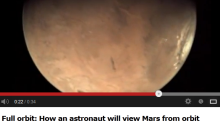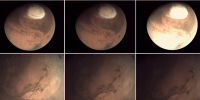It’s been a busy week for Mars with the announcement that NASA’s Curiosity rover has made the first definitive detection of Martian organic chemicals in material on the surface (see “NASA Rover Finds Active and Ancient Organic Chemistry on Mars“). We’ve known for some time that there’s methane in the atmosphere (see “Mars Express confirms methane in the Martian atmosphere“), but this is the first confirmation of organic carbon in a rock on Mars.
Our own (much more modest!) contribution to Mars news this week comes right here at the VMC blog. We are delighted to announce that, in addition to the full image sets in Flickr, the entire VMC RAW-format image archive is now available for download.
The archive contains the unprocessed versions of every image the VMC camera on Mars Express has ever taken since launch back in 2003. These include the 2003 Beagle separation images, the Earth observation from 2014 and the images used to create the 2012 full orbit videos!
The data are available in two ways:
- There are zip files containing the full image set for each individual observation with the date and time of the observation in the zip file name; these are arranged in folders for each year/month with subfolders containing that month’s observations.
- We also have full yearly sets of observations for download to make it easier for those who want to get the entire dataset; note the gap between 2003-2007 is due to VMC not being used in this period.
These files are contain exactly what was/is sent back to Earth from Mars Express. The only processing performed by the mission team at ESOC is to extract the image data from the packets received from the spacecraft and assemble these into the individual raw-format image files (as each image is split across several packets). As a result, anyone who wants to have a go at processing these files is working with genuine raw spacecraft data.
Note that for Flickr, we currently run the downloaded images through a standard set of tools to adjust contrast sharpness and colour levels – exactly the same processing is done for every image VMC acquires. While this produces some good pictures, it is clear that tailoring processing to a specific image can bring out even more details and an even better end result.
We invite you to give it a try! Some of the best VMC images we have seen have been those processed by members of the public.
Further information about the image format and about VMC itself can be found in our FAQ page.
This photo was taken by MEX 24.09 at 07:21.18UT, just a few hours after @MarsOrbiter orbit insertion! #MOM pic.twitter.com/WmNGUbr90N
— VMC – Mars Webcam (@esamarswebcam) September 25, 2014
More cool news
The other big upgrade we can announce is that the extraction and upload of the files downloaded from Mars Express – both to the raw archive and Flickr – has now been automated such that the images will be available in both archives within hours of them arriving on Earth, day or night.
This automated process is also now connected to the @esamarswebcam Twitter account, so when new images are uploaded, anyone who follows this account will be notified straight away! So, really, following the @esamarswebcam Twitter account is the best way to be kept up to date with VMC images as they are delivered live from Mars!
– Simon Wood
MEX Spacecraft Operations Engineer



Discussion: no comments